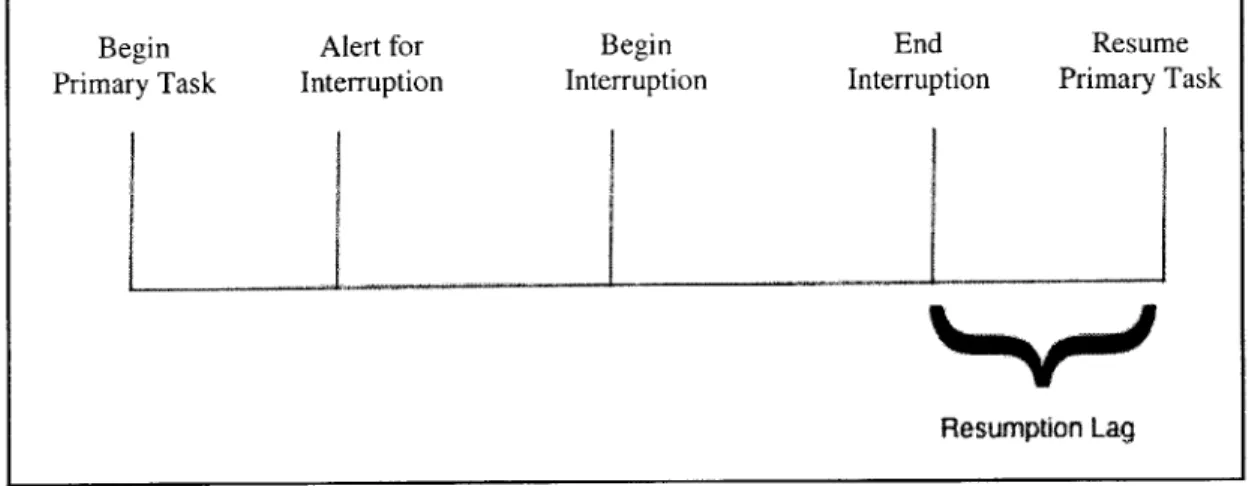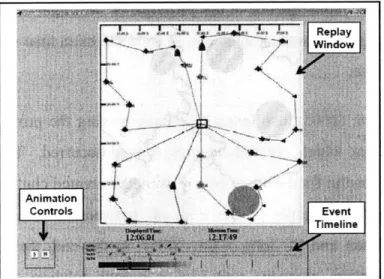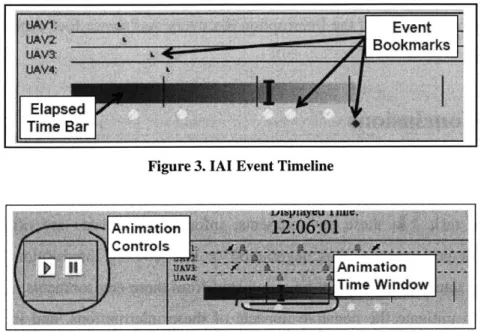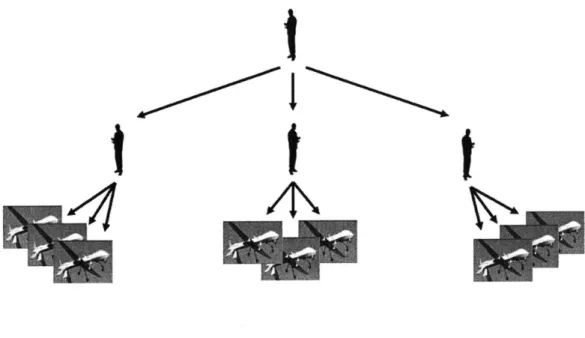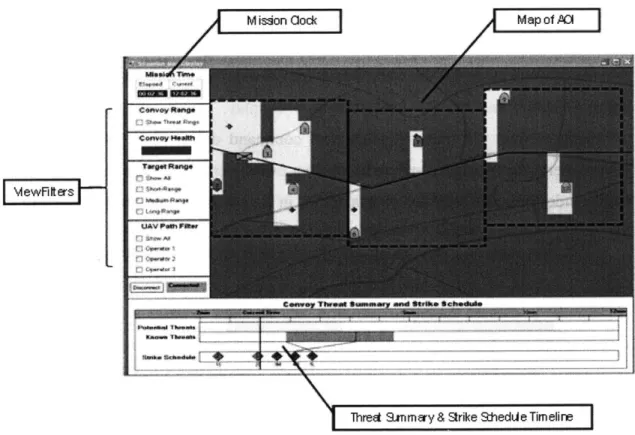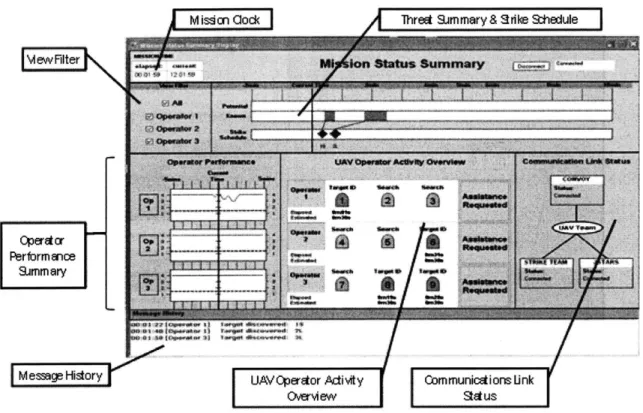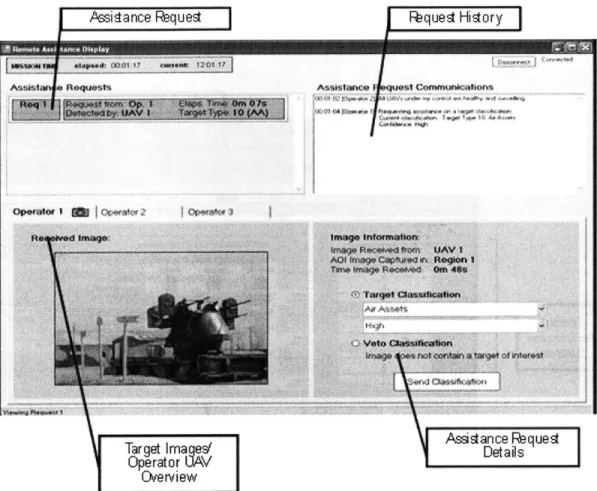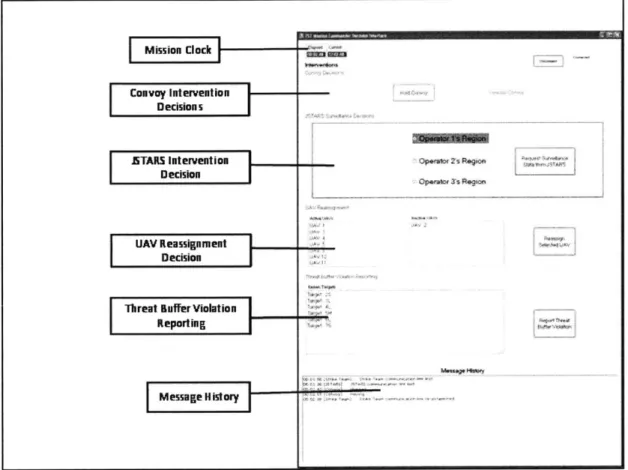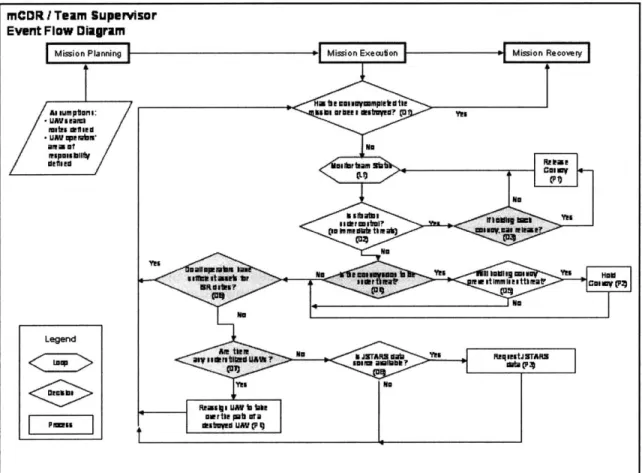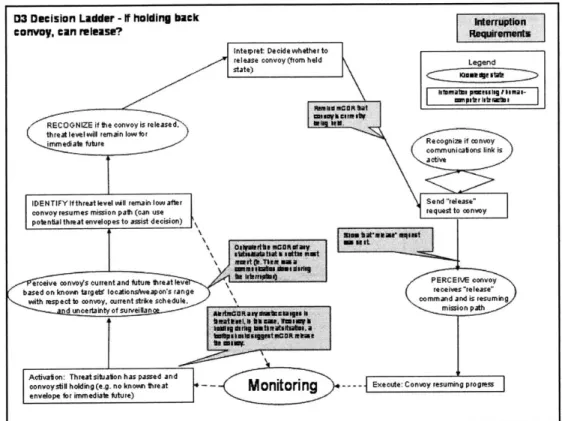Assisting Interruption Recovery in Mission
Control Operations
by
Jordan Wan
B.S. Computer Science MIT, 2007
Submitted to the Department of Electrical Engineering and Computer Science in Partial Fulfillment of the Requirements for the Degree of
Master of Engineering in Electrical Engineering and Computer Science
at the Massachusetts Institute of Technology May 2007
C 2007 Jordan Wan. All rights reserved
The author hereby grants to M.I.T. permission to reproduce and
to distribute publicly paper and electronic copies of this thesis document in whole and in part in any medium now known or hereafter created.
Author
Humans and Automation Laboratory May 14, 2007 Certified by ... Accepted by ... MrASSACHUSETS INSTITt. OF TECHNOLOGY
3 2007
... Missy) Cummings d Astronautics .sis Supervisor ... Arthur Smith Professor of Electrical Engineering Chairman, Department Committee on Graduate ThesesAssisting Interruption Recovery in Time Sensitive
Targeting Mission Control Operations
by
Jordan Wan
Submitted to the Department of EECS
On May 14, 2007 in Partial Fulfillment of the Requirements for the Degree of Master of Engineering in Electrical Engineering and Computer Science
Frequent interruptions are commonplace in modem work environments. The negative impacts of interruptions are well documented and include increased task completion and error rates in individual task activities, as well as interference with team coordination in team-based activities. The ramifications of an interruption in mission control operations, such as military command and control and emergency response, can be particularly costly due to the time and life-critical nature of these operations. The negative impacts of interruptions have motivated recent developments in software tools, called interruption recovery tools, which help mitigate the effects of interruptions in a variety of task environments. However, mission control operations introduce particular challenges for the design of these tools due to the dynamic and highly collaborative nature of these environments.
To address this issue, this thesis investigates methods of reducing the negative consequences of interruptions in complex, mission control operations. In particular, this thesis focuses on supporting interruption recovery for team supervisors in these environments, as the research has shown that supervisors are particularly susceptible to frequent interruptions. Based on the results of a requirements analysis, which involved a cognitive task analysis of a representative mission control task scenario, a new interruption recovery tool, named the Interruption Recovery Assistance (IRA) tool, was developed. In particular, the IRA tool was designed to support a military mission commander overseeing a team of unmanned aerial vehicle (UAV) operators performing ground force protection operations. The IRA tool provides the mission commander a visual summary of mission changes, in the form of an event bookmark timeline. It also provides interactive capabilities to enable the commander to view additional information on the primary task displays when further detail about a particular mission event is needed.
The thesis also presents the findings from a user study that was conducted to evaluate the effectiveness of the IRA tool on interruption recovery during collaborative
UAV mission operations. The study produced mixed results regarding the effectiveness
of the IRA tool. The statistical analysis indicated a negative impact on recovery time, while indicating a positive impact on decision accuracy, especially in complex task situations. The study also indicated that the effect of the IRA tool varied across differ user populations. In particular, the IRA tool tended to provide greater benefits to participants without military experience, compared to military participants involved in the study. The qualitative findings from the study provided key insights into the impact and utility of the IRA tool. These insights were used to identify several future research and design directions related to interruption recovery in mission control operations. Thesis Supervisor: Mary (Missy) Cummings
Acknowledgements
I want to take this opportunity to give thanks to all those who have contributed to my
master's thesis at MIT.
First of all, I would like to thank Missy Cummings, my faculty supervisor at MIT. Missy's vision and dedication to her students really inspired me to work hard and realize the importance of my work. She was instrumental in giving prompt, constructive criticism that improved my research and challenged me to think critically about my research.
Stacey Scott was my post-doc supervisor and she was the person I worked most closely on this research. Without her knowledge, patience and willingness to assist me in the various stages of my thesis, I could not have completed this work. I am truly grateful for the countless hours she put in to revise and edit my thesis.
Thank you to Humans and Automation Laboratory and the wonderful people whom I was able to work with on a daily basis. Jacob Crandall, Mark Ashdown, Gilles Coppin, Yves Boussemart, Dhiman Bhattacharjee, Jessica Marquez, Sylvain Bruni, Amy Brzezinski, Carl Nehme, Scott Fisher, Hudson Graham, and Fernanda Borques da Silva. Also, I would like to thank Rebecca Myers for her help with my data analysis and Sally Chapman, for all of her help in her role as the facilitator of our lab.
I would also like to thank Boeing for their generosity and funding who made my Master's
education possible.
And last but not least, I would like to thank my family and their constant support. My mother and father's value of education and their own examples of hard work and overcoming obstacles as first generation immigrants to North America made me realize the importance of family, education, and that nothing is impossible with a little perseverance and a lot of heart.
Jordan Wan May 6, 2007
Contents
CH APTER 1: INTRODUCTION ... 10 1.1 M OTIVATION...11 1.1.1 Interruptions... 12 1.1.2 Team Supervision... 13 1.2 RESEARCH OBJECTIVES... 14 1.3 THESIS OVERVIEW ... 15CHAPTER 2: BACKGROUND AND RELATED WORK...17
2.1 INTERRUPTION RECOVERY ... . . ... 17
2.2 CHANGE BLINDNESS ... 19
2.3 LOGGING OF KEY EVENTS... 19
2.4 VERBAL QUERIES... 20
2.5 INSTANT REPLAY ... 21
2.6 CONCLUSIONS ... 24
CHAPTER 3: INTERRUPTION RECOVERY ASSISTANCE TOOL ... 25
3.1 TEAM TASK ENVIRONMENT AND EXPERIMENT PLATFORM ... 25
3.1.1 M ap Display ... 28
3.1.2 M ission Status Display ... 28
3.1.3 Remote Assistance Display... 29
3.1.4 M ission Commander Interface... 30
3.2 REQUIREMENTS ANALYSIS FOR ASSISTING INTERRUPTION RECOVERY IN THE TEAM TASK ENVIRONMENT... 31
3.2. 1 Cognitive Task Analysis ... 32
3.2.2 D esign Recommendations from Related Literature ... 36
3.3 CONCEPTUAL DESIGN OF THE INTERRUPTION RECOVERY ASSISTANCE TOOL ... 37
3.4 DESIGN DETAILS OF THE IRA TOOL ... 38
3.5 INTERACTION DESIGN OF THE IRA TOOL ... 40
3.6 SUMMARY ... 42
CHAPTER 4: ... 43
4.1 EXPERIMENT OBJECTIVES ... 43
4.2 EXPERIMENT HYPOTHESES...43
4.2.1 Interruption Recovery Performance... 43
4.2.2 Overall Task Performance ... 45
4.3 PARTICIPANTS ... 45
4.4 EXPERIMENTAL SETUP ... 46
4.5 EXPERIMENTAL TASKS... 47
4.5.1 Primary Task... 47
4.5.2 Secondary (Interruption) Task ... 48
4.6 INTERRUPTION DESIGN...48
4.7.1 Independent Variables... 49
4.7.2 Dependent Variables... 51
4.8 EXPERIMENT PROCEDURE ... 52
4.9 DATA COLLECTION ... 53
CHAPTER 5: RESULTS & DISCUSSION ... 55
5.1 OVERVIEW OF PERFORMANCE RESULTS...55
5.2 INTERRUPTION RECOVERY PERFORMANCE ... 56
5.2.1 Interruption Recovery Time Performance ... 56
5.2.2 Decision Accuracy Performance... 58
5.3 OVERALL TASK PERFORMANCE ... 60
5.4 DISCUSSION OF PERFORMANCE RESULTS ... 61
5.4.1 Interruption Recovery Performance... 61
5.4.2 Overall Task Performance ... 62
5.5 QUALITATIVE RESULTS... 63
5.5.1 Interruption Recovery Strategies ... 63
5.5.2 Usability Issues with IRA ... 65
5.6 SUMMARY ... 68
CHAPTER 6: CONCLUSION...70
6.1 RESEARCH OBJECTIVES AND FINDINGS ... 70
6.2 RECOMMENDATIONS AND FUTuRE W ORK...72
APPENDIX APPENDIX APPENDIX APPENDIX APPENDIX APPENDIX APPENDIX APPENDIX APPENDIX APPENDIX APPENDIX A: DETAILED DIAGRAMS FROM COGNITIVE TASK ANALYSIS.73 B: INTERRUPTION RECOVERY REQUIREMENTS...78
C: DEMOGRAPHIC DATA ... 79 D: INTERRUPTIONS...80 E: INCIDENCE REPORT... 83 F: INFORMED CONSENT...84 G: DEMOGRAPHICS ... 87 H: POWERPOINT TUTORIAL...89 I: POST-TUTORIAL SCRIPT ... 102 J: INTERVIEW QUESTIONS...103 K: STATISTICAL TESTS ... 104 BIBLIO G RA PH Y ... 105
List of Figures
Figure 1. Interruption & recovery process . ... 18
Figure 2. Interruption Assistance Interface (main display)...22
Figure 3. IAI Event Timeline ... . ...- 23
Figure 4. IAI Animation Controls...23
Figure 5. The UAV team structure ... 26
Figure 6. Map Display...28
Figure 7. Mission Status Display. ... 29
Figure 8. Remote Assistance Display. ... ... 30
Figure 9. M ission Comm ander Interface... ..31
Figure 10. Event Flow Overview ... 33
Figure 11. Decision ladder for D3 ... 34
Figure 12. Decision ladder for D4 ... 34
Figure 13. Decision ladder for D6 ... 35
Figure 14. Decision ladder for D7 ... -... 35
Figure 15. Interruption Recovery Assistance (IRA) event timeline...38
Figure 16. The IRA timeline integrated in the Mission Commander Interface. ... 39
Figure 17. Revealing the Convoy Attacked event information on the Map Display...40
Figure 18. Revealing the UAV Destroyed event information on the Map Display...41
Figure 19. Revealing the Late Strike event information on the Map Display. ... 41
Figure 20. Experimental Facility... 46
Figure 21. Mission Commander Interface (a) with Assistance , (b) with no Assistance.50 Figure 22. Interruption recovery time by military experience. ... 57
Figure 23. Decision accuracy score...59
Figure 24. Complex decision accuracy scores by military experience. ... 59
List of Tables
Table 1. IR A tim eline events... 39 Table 2. Description of Experimental Interruptions... 49 Table 3. Interruption recovery time summary... 58 Table 4. Frequency of decision accuracy scores (Suboptimal: DA=1, Optimal: DA=2).58 Table 5. Convoy health score summary... 60
Nomenclature
AcronymsAOI Area of Interest
CEO Chief Executive Officer
DL Decision Ladder
HSC Human Supervisory Control
IAI Interruption Assistance Interface
IR Interruption Recovery
IRA Interruption Recovery Assistance IRT Interruption Recovery Time
JSTARS Joint surveillance and target attack radar system
mCDR Mission Commander
MCI Mission Commander Interface (tablet PC)
MSD Mission Status Display
MD Map Display
RAD Remote Assistance Display
SS Simulation Server
Chapter
1:
Intmduction
In modem work environments, people are regularly bombarded with interruptions. These interruptions often stem from people's computers, for example, from instant messaging programs, email clients, and scheduled computer maintenance tasks. Interruptions also occur from non-computer-based sources, such as telephone calls and co-workers stopping
by for assistance.
Research has shown that such interruptions can have a variety of negative consequences. For example, interruptions can increase job stress, task completion times, and error rates in individual task activities (Kirmeyer 1988; Cellier and Eyrolle 1992; Czerwinski, Cutrell et al. 2000; Czerwinski, Cutrell et al. 2000). Empirical studies have shown that, in general, interruptions can negatively impact overall task performance (Monk, Boehm-Davis et al. 2002; Trafton, Altmann et al. 2003; Altmann and Trafton 2004). Research has also shown that interruptions can also cause coordination problems, work overload, and time pressure in team-based activities (Reder and Schwab 1990; Jett and George 2003). Depending on the criticality of the task being performed, the ramifications of interruptions can vary from being mildly annoying or socially embarrassing to potentially leading to loss of equipment or life (Bailey, Konstan et al. 2000; Tucker and Spear 2006).
In team oriented work environments, collaboration requires multiple interactions among co-workers and their supervisors. With the addition of instant messaging and other forms of collaboration technologies, it has become increasingly easy to interrupt someone, even from a distance. Team supervisors are particularly susceptible to interruptions in the work place (Jett and George 2003). In a study by Oshagbemi (1995),
it was found that significant improvements in the use of a supervisor's time can be obtained by addressing workplace interruptions and their negative impacts through delegation, rescheduling and minimizing the frequency of interruptions.
In some cases, the negative consequences of interruptions can be mitigated through rescheduling using a computer mediator or social negotiation mechanisms (McFarlane and Latorella 2002; Dabbish and Kraut 2004). In these situations, the flexibility of the task environment can allow the user to determine when they want to be interrupted and thereby reduce the cost of an interruption.
While interruptions can be a negative source of distraction, they are often the source of critical and highly relevant information. For example in medical or military task environments, interruptions often take the form of colleagues relaying urgent information that has direct impact on someone's current decision making activities (Tucker and Spear 2006). When the importance of receiving current information updates is likely to outweigh the potential negative effects of an interruption, it may not be appropriate to reschedule or negotiate when interruptions will occur.
The primary goal of this thesis is to investigate alternative methods of reducing the negative consequences of interruptions in complex, time-critical task environments in which the timing of the interruptions cannot be controlled. In particular, this thesis focuses on methods of minimizing the impact of interruptions on team supervisors in such time-critical environments, as research has shown that they tend to be the most vulnerable to interruptions in collaborative environments (Oshagbemi 1995; Jett and George 2003).
1.1
Motivation
Mitigation of the negative effects of interruptions on computer-based tasks through computer facilitation is known as interruption recovery and concerns the process of transitioning from an interruption back to the original task. Depending on the type of interruption, the recovery period can be a lengthy process. The duration of the
interruption recovery process is contingent on the time needed for a person to recall where they were in the task and what activities are required before they can effectively continue the task. Thus, the challenge of a computer-based interruption recovery assistance tool is to help minimize the time and mental effort needed to resume a person's original task. This section will discuss the fundamental research of interruptions and team supervision as to create the foundation for the research domain of this thesis.
1.1.1
Interruptions
Corragio (1990) defines an interruption as an "externally-generated, randomly occurring, discrete event that breaks continuity of cognitive focus on a primary task". From this definition, it can be deduced that an interruption is an external distraction (by someone or something other than the person being distracted), that is beyond the control of the individual being interrupted.
Cognitively, an interruption interferes with memory capacity and diverts the decision maker's attention away from the primary task (Kahneman 1973). This interference typically leads to disruptions in ongoing thought processes (Tetard 1999), likely contributing to the delays often observed in post-interruption task resumption. Such delays are referred to as reorientation time (Gillie and Broadbent 1989), resumption lag (Altmann and Trafton 2004), or interruption recovery time (Scott, Mercier et al. 2006), and are discussed further in Chapter 2. Research also indicates that erratic disruptions can induce personal stress that can negatively affect post-interruption performance
(Cohen 1980).
In certain work environments, the introduction of interruptions actually improves performance (Speier, Valacich et al. 1997). Specifically, Speier et al. (1997) found that when tasks are simple, human operators tend to occupy their unused cognitive capacity with non-task-related activities. Thus, being interrupted actually requires them to focus more deeply on the primary task, resulting in better overall performance. However, Speier et al.'s research also found that when people are involved in complex or cognitively demanding tasks, interruptions can decrease their performance. The decrease
in performance can be attributed to the nature of complex tasks requiring parallel processing of multiple sources of information. Interruptions that occur in complex environments generate an additional thread of a parallel cognitive process, which can interfere with original task's processes (Tetard 2000).
Another facet of why interruptions are such a prominent issue in modem work environments is that people have a natural tendency to multitask (Cherry 1953; Cypher
1986; Woods. 1995). Multitasking is a skill set that is unreliable and vulnerable to other
events that can cause human mistakes (McFarlane and Latorella 2002). In some work environments, a certain number of mistakes may be acceptable and have little impact on overall task performance. However, in time- or life-critical task environments, such as emergency response or military operations, the consequences can be extremely detrimental. Therefore, it is important to consider the environment in which interruptions occur. The following section will discuss team environments, and how interruptions can interfere with collaboration.
1.1.2
Team Supervision
With advances in technology and the globalization of economies, the organizational structures of work environments are becoming more dynamic (Brown and Eisenhardt
1998) and team-oriented (Gordon 1992; Devine, Clayton et al. 1999). Naturally, collaboration and leadership from team leaders are central to the success of many team environments, especially in large organizations. Team supervisors are usually responsible for the success of the entire team, and thus they must monitor the performance and assist their subordinates when necessary. As mentioned earlier, team supervisors are particularly susceptible to negative impacts from interruptions. One study has shown that supervisors fail to return to their prior activities almost 50% of the time following an interruption (O'Conaill and Frohlich 1995). The disruptiveness of interruptions on team supervision is compounded by the fact that an interrupter tends to gain more from the exchange than an interrupted person (O'Conaill and Frohlich 1995). Over time, this unequal benefit tends to disadvantage the team supervisor, leaving them little time to complete their own work duties (Jett and George 2003).
A detailed assessment of how managers spend their time reveals some interesting
trends. Traditionally, the role of a team supervisor is to plan, organize, lead, coordinate and control (Fayol 1949). However, a more recent studies of team supervisors have found that supervisors spend the majority of their long work days (on average, 10 hours per day) in scheduled and emergency meetings, on the phone, or having spontaneous communications in order to request or provide assistance (Reder and Schwab 1990; Oshagbemi 1995). Team supervisors also tend to have more emergency meetings than scheduled ones, though the time spent in scheduled meetings is usually longer (Oshagbemi 1995).
Senior supervisors, such as Chief Executive Officers (CEOs), can experience interruptions at alarmingly frequent rates, including every eight to 22 minutes (Carlson
1951; Mintzberg 1973). Arguably, the frequency of interruptions will fluctuate within
different work domains and specific work populations. However, it is certain that frequent interruptions can force team supervisors to think through important issues in extremely short blocks of time (Sproull 1984; Reder and Schwab 1990). As supervisory-level decision making and task activities ultimately impacts overall team performance, minimizing the disruptiveness of the interruptions supervisors encounter could improve their productivity, but also the productivity of the entire team.
The challenges of team supervision are not limited to just having to deal with interruptions from subordinates and coworkers. The interactions that occur in today's complex environments are no longer purely human-human. The next section will consider the effects of interruptions in task domains that involve human interaction with intelligent computer systems.
1.2
Research Objectives
In order to address the issues raised in the previous section, the overarching goal of this research is to develop an interruption recovery assistance tool for team supervisors in a
complex, collaborative human supervisory control task environment. This goal will be addressed through the following research objectives:
" Objective 1: Determine the interruption recovery requirements for team
supervisors in a complex human supervisory control team environment. In
order to achieve this objective, a literature review and a cognitive task analysis were conducted to identify interruption requirements for a representative complex, collaborative human supervisory task. The results of this requirements analysis
are detailed in Chapter 3.
" Objective 2: Develop an interruption recovery tool for a representative
complex human supervisory control team environment. Based on the
requirements analysis, an interruption recovery assistance tool was designed. The design goals for this tool and its integration into an existing experimental task environment are discussed in Chapter 3.
" Objective 3: Evaluate the effectiveness of the new interruption recovery tool for team supervisors in a complex human supervisory control team environment. To achieve this objective, a user study was conducted to evaluate
the proposed design of the interruption recovery assistance tool. The complete description of the study and its results can be found in Chapters 4 and 5.
1.3
Thesis Overview
This thesis is organized into the following chapters:
" Chapter 1, Introduction, introduces and describes the motivation and research
objectives of this thesis.
" Chapter 2, Background and Related Work, provides a summary of prior research related to interruption recovery and the current technological state of interruption recovery assistance tools in the human supervisory control domain.
" Chapter 3, Interruption Recovery Assistance Tool, describes the interruption
recovery requirements analysis, the resulting design of a new interruption recovery assistance tool, and the representative complex, collaborative human supervisory
control task environment upon which the requirements analysis and the proposed interruption recovery assistance tool are based.
" Chapter 4, Evaluation Methodology, presents a user study that was conducted to
evaluate the effectiveness of the interruption recovery assistance tool described in Chapter 3. Details about the objectives, participants, and procedures utilized in the experiment are outlined.
" Chapter 5, Results and Discussion, discusses the statistical and qualitative results
of the experiment described in Chapter 4. Implications of these results for the design of future interruption recovery assistance tools for time-critical environment are discussed.
" Chapter 6, Conclusions, summarizes the motivation and objectives of this research,
how well the objectives were met, and the key contributions. Suggestions for future work are also provided.
Chapter 2: Background and
Related Work
This chapter provides an overview of the previous research that has been done on interruption recovery. Research in the field of interruption recovery has generally focused on three main areas: investigating the effects of interruptions (Monk, Boehm-Davis et al. 2002; Speier, Vessey et al. 2003; Trafton, Altmann et al. 2003; Altmann and Trafton 2004), developing strategies for managing interruptions, including intelligent alerting and notification of computer-initiated interruptions (McFarlane and Latorella 2002; Dismukes 2003; Chen and Vertegaal 2004; Trafton, Altmann et al. 2005), and developing tools and strategies that minimize the negative impacts of interruptions (Daniels, Regli et al. 2002; St. John, Smallman et al. 2005; Scott, Mercier et al. 2006). This thesis is concerned with the latter research direction: developing decision aids to mitigate interruptions. This chapter provides an overview of the related work in this area. First, the interruption recovery research in typical computing environments is discussed, followed by relevant research on interruption recovery in human supervisory control environments, especially for complex collaborative task environments.
2.1
Interruption Recovery
Interruption recovery research generally focuses on developing tools that attempt to decrease the "resumption lag" that occurs after an interruption has occurred. Resumption lag, also known as reorientation time (Gillie and Broadbent 1989) or interruption recovery time (Scott, Mercier et al. 2006), is the "time between leaving the secondary task and beginning the primary task after an interruption" (Trafton, Altmann et al. 2005). Figure 1 shows the timeline of a typical interruption and task resumption process.
Begin Alert for Begin End Resume Primary Task Interruption Interruption Interruption Primary Task
I
..
...
Resumption Lag
Figure 1. Interruption & recovery process (St. John, Smallman et al. 2005; Trafton, Altmann et al. 2005).
One approach to minimizing a user's interruption recovery time is to provide support within the primary task interface to help the user recall what they were doing before the interruption (Altmann and Trafton 2004). In Altmann and Trafton's study, they investigated the effects of external cues on the resumption lag. They found that when participants were given cues in the form of an eyeball image indicating an interruption was about to occur and a mouse cursor being placed at where they left off after returning from an interruption, their resumption lag was substantially shorter than those who were not given any cues. This implies that the availability of the cues prepared the mental process of the participant to help mitigate the negative effects of the interruption.
In human supervisory control (HSC) domains, in which one or more human operators are responsible for monitoring complex control processes, the task environment, including computer information displays, can dynamically change without direct input from the human operator. Thus, interruption recovery in these task domains depends heavily on understanding any events that occur while a person is distracted by an interruption. The next section discusses an important design challenge for supporting interruption recovery in HSC domains and approaches that have been proposed to address this challenge.
2.2
Change Blindness
Change blindness occurs when large changes within a visual scene go undetected by the viewer. The concept of "change blindness" in interfaces is a well documented problem in many task domains (Rensink 2002; DiVita, Obermayer et al. 2004). Research indicates that people can fail to notice large changes in a visual display especially after looking away from the screen during an interruption (Rensink, O'Regan et al. 1997; Durlach 2004). Specifically, a study by Simon and Ambinder (2005) found that change blindness occurs whenever attention is diverted from the original task. Moreover, they also found that consciously trying to focus one's attention by itself is insufficient for change detection on visual interfaces. However, change blindness has only recently been recognized as a significant challenge in human computer interactions (Smallman 2002; Smallman and St. John 2003; Durlach 2004; Varakin, Levin et al. 2004).
Change blindness is particularly relevant to HSC task environments because of the high frequency of dynamically changing data. In static environments, the information will not be updated (such as word processors, calculators, etc.), and therefore the user does not need to be concerned with observing any changes while they are gone for an interruption. However, in HSC task domains where data is dynamically changing, system changes can occur on a user's computer display while they are attending to an interruption, and change blindness could prevent them from observing these changes. The following sections will describe several approaches that attempt to assist human operators in HSC task environments recover from interruptions, and in particular, provide strategies to mitigate the effects of change blindness in these environments.
2.3
Logging of Key Events
One approach to assist interruption recovery in HSC task environments is to include a basic text log in the user interface (Malin, Schreckenghost et al. 1991; St. John, Smallman et al. 2005; Scott, Mercier et al. 2006). Specifically, a text log is an integrated display that generates ASCII characters in the forms of messages or description boxes. Messages are particularly useful in alerting a user about the occurrence of an event, especially when combined with a time stamp or recorded in an event log.
Malin et al. (1991), for example, provided users of the DESSY (DEcision Support SYstem) a simple text log that kept track of recent events that were relevant to decision making. DESSY is a decision support system used at NASA for space station operators who monitor telemetry data of space shuttles and makes inferences about commands, state transitions, and system failures. In their recovery tool, the description boxes were used to display updated values of state information, such as health and telemetry. This information could be then used to make decisions about mechanical operations of the space shuttle or monitor the health of the hardware on the shuttle.
2.4
Verbal Queries
Most interruption recovery research has focused on mitigating the negative effects of interruptions through the development of visual interfaces (e.g., Smallman and St. John
2003; Altmann and Trafton 2004; St. John, Smallman et al. 2005). An alternative is to
enable users, through verbal queries, to actively control what information they want the system to provide them about its current state and past events. Daniels et al. (2002) developed an interruption recovery tool that uses a spoken dialogue interface to help someone recover from disruptions while tracking logistics requests on behalf of forward deployed ground troops. The interface provides the user with verbal commands that allows them to query the interface about aspects of the previous task. Some of the possible queries were "Where was I?" and "What was I last working on?" In addition, the user can ask specific questions relevant to the task they were working on.
This approach may provide more flexibility and control to the user, since it enables them to use the visual channel for something else besides checking for visual signs of missed events or previous task activities during task resumption. However, in aviation simulation studies, Helleberg and Wickens (2002) and Latorella (1998) have found that an secondary auditory task would compete with the primary visual flight task for the same mental resources and can interrupt the visual flight task entirely. This finding is consistent with auditory-visual time sharing research of Wickens and Liu (1988) and with general multiple resource theory that hypothesizes differences in dual-task performances (Wickens 2002). This previous research suggests that introducing an
additional thread of auditory process may increase complexity and potentially interfere, rather than assist, primary task performance.
2.5
Instant Replay
The design approaches discussed above are still vulnerable to the effects of change blindness, since a new message in a text log could easily be misinterpreted as something that has already been dealt with upon quick glance. Similarly a user could forget to ask the verbal query system the appropriate questions, potentially missing critical information. An alternative strategy for mitigating the effects of change blindness is to provide an 'instant replay' of dynamically changing system elements (St. John, Smallman et al. 2005; Scott, Mercier et al. 2006). To minimize the necessary replay time and enable quick discovery of situation changes, systems typically allow users to replay the interrupted period at higher than real-time speed (e.g. 10 x real-time).
In St. John et al.'s (2005) research, they used a realistic simulation of air warfare as the tasking environment in order to evaluate the effectiveness of the instant replay feature to decrease interruption recovery time. They found that the instant replay tool did not help with identifying changes during the interruption, and it actually imposed a delay. The delay was a direct consequence of the participants' willingness to watch the temporal sequence even though they were not benefiting from the extra time spent on replaying the interruption sequence.
St. John et al. (2005) also investigated augmenting the primary display interface with change markers, which notified changes as they occurred. They found that while this technique was useful for detection of key events, it created clutter and was distracting. This provides a good example of the trade-off between information availability and distraction (Smallman and St. John 2003; 2005). In the end, they found that the best performing interruption recovery tool was a hybrid solution to the instant replay paradigm. Their proposed tool was named CHEX (Change History EXplicit). The task environment used an interface that consisted of a large spatial map display, a data display,
The CHEX tool was designed to give constant awareness information to the user about key changes that occur without overloading the primary interface with clutter. CHEX accomplishes this by instantly populating a table with new changes to the task environment as they occur, and bookmark the event in a pre-assigned row (each row represents a specific monitored event) in the table. Since the CHEX is located on a peripheral display, it bridges the Proximity Compatibility Principle (Wickens and Carswell 1995) gap by allowing the user to click on the CHEX tool to highlight the change information on the primary display. This removes clutter but allows the user to request detailed information when they needed.
Scott et al. (2006) also investigated the use of instant replay tools to assist interruption recovery in HSC task environments. In particular, they examined the impact of various replay design approaches on interruption recovery in the supervisory control of semi-autonomous unmanned aerial vehicles (UAVs). In this work, a recovery tool called the Interruption Assistance Interface (IAI) was provided on a separate, peripheral display adjoining the main UAV operator interface displays. The IAI consists of a replay window (Figure 2), an event timeline (Figure 3), and a set of animation controls (active
only when animated replay is available) (Figure 4).
Figure 3. IAI Event Timeline
Figure 4. IAI Animation Controls
Consistent with the design recommendations made by St. John et al. (2005), the IAI is always available, peripheral, and updated as events occur in the main task environment. In the study, Scott et al. (2006) compared one version of the IAI that provided bookmarked assistance with another that provided animated assistance. The bookmark assistance displayed key events in the history of the task environment and allowed the user to jump to the discrete time periods in which the events occurred. The animated assistance allowed the user to view an accelerated animated sequence of historic events by selecting a desired time window in the event timeline.
The results from their study indicate that the IAI replay assistance is particularly useful when the participants face complex system changes after an interruption. Scott et al. (2006) recommended further investigation of tools to mitigate the disadvantages of interruptions when only simple system changes have occurred. In addition, they recommended further investigation of how to indicate time relationships between present and past system states. In particular, they recommend the integration of the replay aspects of an interruption recovery tool in the main primary display to minimize the distraction of investigating past events on a separate displays. Ironically, using a peripheral interruption recovery tool leaves the user vulnerable to missing new events
that may be occurring in the main task displays. These two recommendations were inspirations to the design of the Interruption Recovery Assistance tool explained in detail in Chapter 3.
2.6
Conclusions
Supporting interruption recovery in highly dynamic, time-sensitive task environments is not an easy task. In these environments, information updates are often critical to effective task performance, thus negotiation or rescheduling interruptions may not be feasible. As interruptions cannot be eliminated from these environments, it is important to attempt to mitigate the negative impacts of these interruptions, and in particular to minimize the time and effort required for task resumption.
Based on the previous interruption recovery approaches described in this chapter, the next chapter describes the development of an interruption recovery tool designed to support team supervisors overseeing teams comprised of both humans and intelligent systems in time-sensitive military command and control task environments.
Chapter 3: Interruption Recovery
Assistance Tool
The goal of this chapter is to determine the interruption recovery requirements for team supervision in a representative complex human-supervisory control team environment, and to develop an interruption recovery tool for that representative task environment. The chapter first describes the representative team task environment and the user interface displays used in this environment to assist supervisory-level decision making. Next, the chapter describes the interruption recovery requirements analysis that helped derive the design requirements for an interruption recovery aid for the team task environment. This analysis includes a cognitive task analysis for the supervisory role in the task environment and a review of design recommendations from the related literature. Finally, the chapter discusses the design of the Interruption Recovery Assistance (IRA) tool.
3.1
Team Task Environment and Experiment Platform
In order to develop interruption recovery assistance for team supervisors in a complex human-supervisory control team environment, an existing experimental platform for investigating teams of semi-autonomous unmanned aerial vehicle (UAV) operators engaged in time-critical military missions was used (Scott, Wan et al. 2007). This task environment involves supervision of both human operators and intelligent systems (i.e., multiple UAVs), thus, providing a representative complex human-supervisory control team environment.
In this task environment, a "mission commander" is given the task of supervising three UAV operators, each monitoring multiple UAVs performing surveillance and target identification. Figure 5 shows the team structure. The overall mission goal of UAV team is to secure safe passage for an important political convoy through an area of interest
(AOI) which is potentially hostile.
Figure 5. The UAV team structure, showing the relationship between the mission commander (top), the UAV operators (middle), and the UAVs (bottom).
In this UAV team task environment, the mission commander is responsible for ensuring the safety of the convoy and for managing the workload of the UAV operators on his or her team. To achieve these objectives, the mission commander can make several types of strategic decisions. These decisions include:
. Requesting the convoy hold its current position if the intended path is not deemed safe for passage.
. Requesting supplementary surveillance data from a nearby joint surveillance and target attack radar system (JSTARS). JSTARS is a long-range, air-to-ground aircraft surveillance system designed to locate and identify ground targets in all weather conditions.
. Re-tasking of one UAV to a different sub-AOI (requiring the handoff of a UAV between operators).
If a UAV identifies a hostile target, an external strike team is contacted to destroy
the target. The scheduling of these target strikes is controlled by this strike team and is non-negotiable. Thus, if the strike team cannot destroy a target prior to the convoy entering its weapons range, the mission commander must hold the convoy until the strike team has time to neutralize the target.
The UAV team task is performed in an experimental laboratory designed to emulate a small command center, as described in Section 4.4. In this simulated command center, the UAV team mission commander has access to three large-screen displays that provide various types of mission-related information: the Map Display, the Mission Status Display, and the Remote Assistance Display, which will be detailed in the following section. In order to implement command decisions in this simulated task environment, the mission commander uses an experimental interface called the Mission Commander Interface provided on a tablet PC in the command center environment.
In this scenario, interrupting the mission commander can potentially have a huge, negative impact on the entire mission. Since it is the responsibility of the mission commander to oversee the entire operation, any situation in which a UAV or an operator is underperforming requires the mission commander to rapidly resolve the issue. Thus, if an external interruption occurs (such as providing a report to a superior or taking a phone call), it is very important that the mission commander is quickly brought up to speed on whether any events that occurred during the interruption require attention. The following sections describe the existing interfaces for this task environment. As described below, the interruption recovery assistance tool developed for this task environment are integrated directly into these existing interfaces, particularly the Map Display and the Mission Commander Interfaces.
3.1.1
Map Display
The Map Display, shown in Figure 6, visualizes geo-spatial information of relevant contacts and assets in the context of the UAV team's geographical area of interest (AOI). The black dotted lines outline the regions of responsibility for each UAV operator. The gray shading on the map indicates areas that have yet to be surveilled by the UAVs. The bottom of the interface shows a threat summary which is designed to display threat regions in relationship to past, present, and future time. This display also provides several tools for changing the level of detail displayed on the map.
Mws:ion Cock
MewFift ers
UAV rath~
...T
~
.~7
.fiu
.ii
...
...
...
IOAM
_UIA _ _ _ _ _ * eco&Threat rnrnry & Strike Rhedtie Timelire
Figure 6. Map Display.
3.1.2
Mission Status Display
The Mission Status Display, shown in Figure 7, visualizes current and expected mission status information, including surveillance progress for each UAV operator, current UAV tasking information, communications link status to external resources, and operator performance. The threat summary at the top of the interface is identical to the one
provided in Map Display. A message history text box at the bottom of the Mission System Display provides a record of all mission events.
I -
Misdrn 22!!k
Thred am mary & 2 ri le ScheduleMew Filter on Status Summary
Ciperdcr Perform
ance-S1mm
ary---MesseHor UAVGpeor Aivy CommunicionsLink
Pverview Stcu
Figure 7. Mission Status Display.
3.1.3
Remote Assistance Display
The Remote Assistance Display (RAD) allows the mission commander to assist UAV operators who are having difficulties with the target identification task (Figure 8). The advantage of having this interface is that it allows the UAV operators to be co-located or remote. The mission commander can use the RAD to assist an operator in classifying a potential target that has been identified by a UAV's onboard automatic target recognition system. If an operator requires assistance with their current target identification, they can send a request to the mission commander via the RAD, which also causes a request alert to be displayed on the Mission Status Display. The mission commander can then view the UAV imagery, alter the target classification information, and submit the updated classification to the operator.
AssiEance Requed
f
A~ t~v~ce 4.qvs~t Cm~n~cs~t~ ii - *1 ~4 -~ I .q~ I ~ ~ ~I
.Assistance Pe que tTar get ImageY Operator FverviewUAV Det ailsFigure 8. Remote Assistance Display.
Mission Commander Interface
3.1.4
The Mission Commander Interface, shown in Figure 9, is used by the mission commander to execute all mission decisions in the simulated task environment. Similar to the Mission Status Display, a message history is provided at the bottom of this display. This message history is a simple text log of all events that occur during the mission (e.g., convoy attacks, UAV tasking, and communication link failures), similar to the text logs discussed in Section 2.3. This message history display provides a basic level of interruption recovery support for the mission commander in this task environment.
Figure 9. Mission Commander Interface.
3.2
Requirements Analysis for Assisting Interruption
Recovery in the Team Task Environment
In order to inform the design of an interruption recovery tool for the UAV team mission commander, a requirements analysis was performed. The analysis involved:
" Augmenting an existing hybrid cognitive task analysis (CTA) (Nehme, Scott et al. 2006) for the UAV team mission commander to derive information and functional
requirements aimed at supporting interruption recovery in the UAV team task environment.
" Drawing advice from the literature described in Chapter 2, particularly from the
work on instant replay described in Section 2.5.
This section describes the details of this analysis both pieces of research and their inspiration towards generating the interruption recovery requirements.
Convoy Intervention
---0Decision s
STARS Intervention
Decision
UAV R ea ssign rn ent
Decision
Threat Buffer Violation Reporting
Message H ist Ory
Op.en 3S
ff
Cognitive Task Analysis
The cognitive task analysis (CTA) leveraged for this thesis included augmenting an existing CTA that was created to inform the design of the large-screen mission commander interfaces described above (Scott, Wan et al. 2007).
The augmented CTA considers the effects of adding interruptions to the task scenario, and how interruptions during mission commander tasking might impact decision making. Figure 10 shows a high-level overview of the flow of events that are likely to occur in this UAV team task environment, from the mission commander's perspective (from Scott, Wan et al. 2007). The motivation for augmenting this CTA was to help identify ways that an interruption recovery tool could mitigate the effects of interruptions in the context of the critical supervisory-level decision making that occurs in this task environment. The augmented version of the CTA includes an event flow diagram (Figure 10) and four decision ladder diagrams (Figures 11-14).
The event flow diagram shows the temporal constraints of the events that can occur in a task scenario. This diagram outlines the loops, processes and decisions that occur in the UAV team task. Of particular interest to this requirements analysis are the decisions that the mission commander is required to make during the task flow (shown as diamonds in Figure 10). Each decision results in a yes or no answer, and potentially requires a complex set of analysis and planning steps to facilitate the decision process. For such complex decisions, a decision ladder is created to detail the analysis and planning aspects of the decision process. Decision ladders are used to capture the states of knowledge and information-processing activities of critical decision points during a task scenario (Rasmussen 1983). The blue diamonds in Figure 10 indicate the decisions that were deemed complex enough to expand into decision ladders for the UAV team task scenario. These decision ladders formed the basis for the interruption recovery requirements analysis.
The decision ladders were created for the command decision related to releasing
(D3, Figure 11) or holding the convoy (D4, Figure 12), assisting an operator (D6, Figure 13), and reassigning a UAV asset to a different operator region (D7, Figure 14). These
decision ladders were then augmented with display requirements related to assisting task resumption at various stages throughout the decision process (blue callouts in Figures 11-14). Larger versions of Figures 10-14 are provided in Appendix A, which show further details.
mCDR I Team Super Event Flow Diagram
Mission Planning Al Rum plum1: UMln eow *UA~Uei' a1mmul idilled Legend
KIoess
visorI
Mission Exe cution Mission Re coveryof Aor e a m sh Reeiz
GRIM
oN
liemill win" M~lockAR
Yes
NUoeti
over tle pah cf a distmPA Um ( 1
03 Decision Ladder -I9 holding back kiterruption
convoy. can release?
Interpret- Decide whether to
release convoy (from held Legend
state)
b n o omatpiselease" 1M21-= it per lsiML-W
RECOGNIZE if he convoy ts releasedu. comIm atir
th reat eve will remain low fo r
immediate f ete rReecognize if convo
communi caions link is active
IDENTIFY Ifthreat level will remain low aftr Send "rel
convoy fesumes missio n p a (can use request to
p olentiaIth re at envel op s to assist d ecisi on)
0 ItImcaKtfa~ ~ ~ ~ ~ 1 T u
ereIiecnoscrent and future 1hreat e e Itlrfo PERCENEf convoy
based on known targe&t Iocatio nsve ap on's range \receives "release"
With resp ect to convoy, current strike sch edule. \command and is resuming
d un ce rta inty of su reilIan Aatocay"ca ]miso pat
aa e isma. Ir=#V I[s
Woansg d ligteretitsaftc. a
Activalion: Threatsitualion has passed and
convoystill holding (e.g. no knobxn thre at
Monitoring
---- .Execoute: Convo rmuning progre envelope for immediate future)Figure 11. Decision ladder for D3 (If the convoy is currently holding, can it be released?), augmented with Interruption Recovery Requirements.
04 Decision Ladder - Is the convoy
cufmenftly I soon to be under threat?
INTERPRET: Decide wheiher to intervene on convoy roule
Updatle h sta"u ofthe convoy
RECOGIZE whether holdn convoy wil diminish threat level
j , I
Legend
IDENTIFY f hreat level will remain high after
delay of implemening hold
kn own ta rget lo catio ns a nd wea po n ra ng e. cu rre nt strik soh e d ul e. an d a ny poteni Al
thres-Activation: Detedion of possible long-range weaponry or other threat thatwill pose a
dangerto convoy in the immediate future OR detection of some regions that are not being surveyed fast enough to ensure convoy safety
ciraruiti.
RECOGNIZE if convoy
communicatons fink is active
Send hold request to
ule rmall al tk a convoy
ri rM t. Pa " tand hodiengat
Eats em em ejtei
-im go Met$ ito rngrtV1C9R1Wat=1W
e PERCEIVE convo
received hold reques
WMr kL- me I vId is holdling
leis tle CMNFUsam C y ntactt
--- ---. Exe oute: C onvoy is h oldhn g
Figure 12. Decision ladder for D4 (Is the convoy in imminent danger?), augmented with Interruption Recovery Requirements.
Figure 13. Decision ladder for D6 (Do the UAV operators have sufficient assets to perform the necessary surveillance?), augmented with Interruption Recovery Requirements.
07 Decision Ladder - Ari there any Interuton
undmutilized UAVs? Reqirermft
Interpret: Decide which tAV
(Qf any) is most appropriate Legend
opion or reassignment
e e o
01MMaIN smesla
fisIMOs-area ~ ~ o ono~ ~ ~ we coreinnnvoyio RECOGNIZE posb e underullized b *h coey
UAVs for reassignment options udrtfzd
add to list
Send reassignment
In tpo Wit of UAVs. e dt od
IDENTIFYthe o e icalityofeach other hig gtors that rea
operatofs zone relaive o he convy and rv
opeator:Xs zones, considering unsurvera ied coneok IR __ Ae
area in region and locaton of convoy that UAVX has witch
pats to UAV Y
erceive sele cted Keep An 1 e o of a UAV carrying out
Perceive pfictitywof current UAVRcaskmg i ptlto thRatequi vers re me etasking ordes
othe r operator re gions compared to o perator Xs (threa assistanc in JR
within range of convoy. current and future surveillan inierfAce a5 W@1 as AN
coverage, available UAV assets) undewilized UAVs (not
- do.n anylhinq
Activaton: OperatorX requires assistance to Eeue upr prtrXb
coninue eficient surveillance and control of -xcue < poidn Suppor adtna UA rsourc regio n to ensure safety of convoyprvdnadioalUVesuc
Figure 14. Decision ladder for D7 (Are any of the UAVs currently being underutilized?), augmented with Interruption Recovery Requirements.
06 Ducision Ladder- Do all operators hwin sufficient assets for ISR duties?
Intoipfet: Decide whether to
assist operator Legend
l1o1m tre stae
R ECO GNIZE it ihe situalion might be 11fmis s 111211 1M
under control by the time an interventon Fmd ago d visual IP.p7t rIiiFnebil
takes place based on expected operator Prese ntabAopn of oei how
perfoirrancei availability of UAV assetsi close is toe ghe uonuUv
nd delay Ime to obtain assstanie theregA andJ dsplay on
tirnelne.
IDENTIFY which operators (if any) have r6 as
----which will not be surveyed before convoy IR indicatestwhich
enlers possible threat envelope range opt ctors vviffneed
irned ate suppoat
Perceive each operains current and future
surveillance pe rformance, available UAV assets.
and their expected paths. 8.kmikine otmln haUA
a destroyed, Aso IR should suggest
actionr thajt mCDR can take Activallon: UAV has been shot down OF SOMe
areas willhin range of convoy will not be
Mo itr g
---- Execute: Atlemnpt to su ppo rt op e ato r by surveilled prior to convoy arrival (or ever). ---- reassigning unused UAVs or external(: Iintelligence (JSTARS) data.
The interruption recovery requirements identified in the augmented CTA were compiled into a list of design requirements (detailed in Appendix B). Of these
requirements, the most salient and reoccurring are listed below:
" Interfaces should provide visual information on how close the convoy is to a threat.
* Interfaces should display when and where a UAV was destroyed.
" Interfaces should highlight an operator's performance if it is deteriorating. " Interfaces should highlight any recent changes in communication status.
Some of these interruption recovery requirements are already supported by the existing decision and collaboration support provided in the large-screen mission commander interfaces. For example, the proximity of the convoy to a threat is already shown as strike envelopes on the strike summary panel of Map and the Mission Status Displays. Also, communication connection states are shown as a visual on the Mission Status Display. However, many are not, which is the subject of the design interventions discussed below. Appendix B provides further details of which requirements are satisfied
by the existing tasking environment.
3.2.2
Design Recommendations from Related Literature
As previously discussed, one approach to displaying past events, such as a UAV being destroyed and a convoy approaching a threat, is to provide an animated instant replay of these previously occurring system events (St. John, Smallman et al. 2005; Scott, Wan et al. 2007). However, such instant replay can increase resumption lag because the user is forced to watch events sequentially, often resulting in time wasted watching irrelevant events along while waiting for relevant events to be displayed. To reduce the time a user wastes watching irrelevant events, Scott et al. (2006) enabled users to control the specific time periods or specific events the system replayed.
To help control the replay of past system events, Scott et al. (2006) provided a visual summary of past critical events, in the form of the event timeline (Figure 3). They found that this visual summary effectively supported decision making and interruption recovery in UAV operations. However, their results also indicated that including redundant or irrelevant visual information in the visual summary can detract from task
resumption. Therefore, an effective recovery tool in this scenario should summarize only mission critical events without overloading the user with information. In particular, Scott et al. (2006) suggest that the visual summary be limited to event relevant for decision making, as identified in the previous section.
Finally, one of the findings of Scott et al.'s (2006) work was that an instant replay tool located on a peripheral display lacked the ability to indicate the relationship between the current system state and past events. They recommended that the event history be overlaid onto (or directly integrated with) the current system state. This approach would directly show past events in relation to current events.
With these design recommendations in mind, a new interruption recovery tool was developed for the UAV team task environment described in Section 3.1.
3.3
Conceptual Design of the Interruption Recovery
Assistance Tool
The combination of the design recommendations discussed above led to the design of an Interruption Recovery Assistance (IRA) tool that provides an interactive event bookmark timeline that highlights past events directly on the Map Display. The IRA is fully integrated onto the tablet PC, located above the command decision controls. The design of the IRA tool is similar to the design of Scott et al.'s (2006) IAI tool, described in Section 3.2.2. However, the IRA event timeline is located on the Mission Commander Interface, and thus is integrated into the interface where command decisions are executed rather than integrated into the spatial map display.
The IRA timeline (Figure 15) contains four rows, each displaying bookmarks of different types of critical mission events: convoy attacks, UAV attacks, late strikes (i.e., targets that are scheduled to be destroyed after the convoy's current path will cross their weapons range), and communication link status changes.
Clicking on an event icon (i.e., an event bookmark) in the IRA timeline results in additional information being displayed on the Map Display, with the exception of the
communication link status change events. The next section discusses the specific events that the IRA timeline displays, the design details, and the corresponding interaction design.
Figure 15. Interruption Recovery Assistance (IRA) event timeline.
3.4
Design Details of the IRA Tool
The events captured and bookmarked on the IRA timeline are listed in Table 1. For each type of event, the table shows the corresponding event icon that is displayed on the IRA timeline, what system event triggers the IRA tool to add the event to the timeline, and the interface changes that occur in the Map Display when a user clicks the event bookmark icon on the IRA timeline. Figure 16 shows the revised Mission Commander Interface with the IRA timeline displayed at the top of the display.
